Influence of the Applied Working Fluid and the Arrangement of the Steering Edges on Multi-Vane Expander Performance in Micro ORC System
Abstract
:1. Introduction
2. Experimental Results and Numerical Model
2.1. Description of the Experimental Test-Stand, the Multi-Vane Expander, and the Experiment Results
2.2. Description of the Numerical Model
- An angular position of a vane defined by θ angle is calculated.
- A vane is rotated by an angle −θ to be aligned with X axis in the initial position of the mesh (see Figure 2).
- Nodes of a vane except the vane tip are elongated or shortened in the X direction. The nodes of the vane tip are just translated in the X direction.
- A vane is rotated back by an angle θ to its actual location.
- Nodes that lay on the rotor and cylinder surface are rotated by an angle β per time step. In the present work, β = 0.1° was used.
- The position of the internal nodes is calculated according to the following diffusion equationwhere δ is the displacement of boundary nodes relative to the previous mesh locations and Γdisp is the mesh stiffness, which determines the degree to which regions of nodes move together. For the present calculations, Γdisp = 1 was used.
3. Results and Discussion
3.1. Analysis of the Influence of the Applied Working Fluid
3.2. Analysis of the Influence of the Arrangement of the Steering Edges
4. Summary and Conclusions
Acknowledgments
Author Contributions
Conflicts of Interest
References
- Hung, T.C.; Shai, T.Y.; Wang, S.K. A review of Organic Rankine Cycles (ORCs) for the Recovery of Low-Grade Waste Heat. Energy 1997, 22, 661–667. [Google Scholar] [CrossRef]
- Kolasiński, P. The Influence of the Heat Source Temperature on the Multivane Expander Output Power in an Organic Rankine Cycle (ORC) System. Energies 2015, 8, 3351–3369. [Google Scholar] [CrossRef]
- Mikielewicz, J.; Mikielewicz, D.; Ihnatowicz, E.; Kaczmarczyk, T.; Wajs, J.; Matysko, R.; Bykuć, S.; Rybiński, W. Obiegi Termodynamiczne ORC Mikrosiłowni Domowej; Institute of Fluid-flow Machinery Publishing: Gdańsk, Poland, 2014; ISBN 978-83-88237-19-5. [Google Scholar]
- Stępień, R. Wybrane Zagadnienia Projektowania Wielostopniowych Mikroturbin Osiowych; Institute of Fluid-flow Machinery Publishing: Gdańsk, Poland, 2013; ISBN 978-83-88237-13-3. [Google Scholar]
- Kozanecki, Z.; Kozanecka, D.; Klonowicz, P.; Łagodziński, J.; Gizelska, M.; Tkacz, E.; Miazga, M.; Kaczmarek, A. Oil-Less Small Power Turbo-Machines (Bezolejowe Maszyny Przepływowe Małej Mocy); Institute of Fluid-flow Machinery Publishing: Gdańsk, Poland, 2014; ISBN 978-83-88237-27-0. [Google Scholar]
- Mikielewicz, D.; Mikielewicz, J.; Ihnatowicz, E.; Muszyński, T.; Wajs, J.; Rybiński, W. Wybrane Aspekty Projektowania i Badań Wymienników Ciepła Dla Obiegu ORC Mikrosiłowni Domowej; Institute of Fluid-flow Machinery Publishing: Gdańsk, Poland, 2013. [Google Scholar]
- Kaniecki, M.; Henke, A.; Krzemianowski, Z. Agregaty Pompowe w Zastosowaniu do Obiegów ORC Mikrosiłowni Kogeneracyjnych na Czynnik Niskowrzący; Institute of Fluid-flow Machinery Publishing: Gdańsk, Poland, 2013; ISBN 978-83-88237-14-0. [Google Scholar]
- Kiciński, J.; Żywica, G. Dynamika Mikroturbin Parowych; Institute of Fluid-flow Machinery Publishing: Gdańsk, Poland, 2014. [Google Scholar]
- Breńkacz, Ł.; Żywica, G.; Bogulicz, M. Selection of the Bearing System for a 1 kW ORC Microturbine. In Proceedings of the 31st Workshop on Turbomachinery, Dresden, Germany, 4–6 October 2017. [Google Scholar]
- Żywica, G.; Kaczmarczyk, T.; Ihnatowicz, E.; Turzyński, T. Experimental investigation of the domestic CHP ORC system in transient operating conditions. Energy Procedia 2017, 129, 637–643. [Google Scholar] [CrossRef]
- Kaczmarczyk, T.; Żywica, G.; Ihnatowicz, E. The impact of changes in the geometry of a radial microturbine stage on the efficiency of the micro CHP plant based on ORC. Energy 2017, 137, 530–543. [Google Scholar] [CrossRef]
- Kaczmarczyk, T.; Żywica, G.; Ihnatowicz, E. Vibroacoustic diagnostics of a radial microturbine and a scroll expander operating in the organic Rankine cycle installation. J. Vibroeng. 2016, 18, 4130–4147. [Google Scholar] [CrossRef]
- Kaczmarczyk, T.; Żywica, G.; Ihnatowicz, E. The Experimental Investigation of the Biomass-Fired ORC System with a Radial Microturbine. Appl. Mech. Mater. 2016, 831, 235–244. [Google Scholar] [CrossRef]
- Kaczmarczyk, T.; Żywica, G.; Kiciński, J.; Ihnatowicz, E.; Turzyński, T.; Bykuć, S. Prototype of the Domestic CHP ORC System: Construction and Experimental Research. In Proceedings of the 3rd International Seminar on ORC Power Systems, Brussels, Belgium, 12–14 October 2015. [Google Scholar]
- Kaczmarczyk, T.; Żywica, G.; Ihnatowicz, E. Experimental Investigation of a Radial Microturbine in Organic Rankine Cycle System with HFE7100 as Working Fluid. In Proceedings of the 3rd International Seminar on ORC Power Systems, Brussels, Belgium, 12–14 October 2015. [Google Scholar]
- Klonowicz, P.; Witanowski, Ł.; Jędrzejewski, Ł.; Suchocki, T.; Lampart, P. A turbine based domestic micro ORC system. Energy Procedia 2017, 129, 923–930. [Google Scholar] [CrossRef]
- Klonowicz, P.; Borsukiewicz-Gozdur, A.; Hanausek, P.; Kryłłowicz, W.; Brüggemann, D. Design and performance measurements of an organic vapour turbine. Appl. Therm. Eng. 2014, 63, 297–303. [Google Scholar] [CrossRef]
- Klonowicz, P.; Heberle, F.; Preißinger, M.; Brüggemann, D. Significance of loss correlations in performance prediction of small scale, highly loaded turbine stages working in Organic Rankine Cycles. Appl. Therm. Eng. 2014, 72, 322–330. [Google Scholar] [CrossRef]
- Lemort, V.; Giullaume, L.; Legros, A.; Declaye, S.; Quoilin, S. A Comparison of Piston, Screw and Scroll Expanders for Small Scale Rankine Cycle Systems. In Proceedings of the 3rd International Conference on Microgeneration and Related Technologies, Naples, Italy, 15–17 April 2013. [Google Scholar]
- Song, P.P.; Zhuge, W.L.; Zhang, Y.J.; Zhang, L.; Duan, H. Unsteady Leakage Flow Through Axial Clearance of an ORC Scroll Expander. Energy Procedia 2017, 129, 355–362. [Google Scholar] [CrossRef]
- Kosmadakis, G.; Mousmoulis, G.; Manolakos, D.; Anagnostopoulos, I.; Papadakis, G.; Papantonis, D. Development of Open-Drive Scroll Expander for an Organic Rankine Cycle (ORC) Engine and First Test Results. Energy Procedia 2017, 129, 371–378. [Google Scholar] [CrossRef]
- Garg, P.; Karthik, G.M.; Kumar, P.; Kumar, P. Development of a generic tool to design scroll expanders for ORC applications. Appl. Therm. Eng. 2016, 109, 878–888. [Google Scholar] [CrossRef]
- Gao, P.; Jiang, L.; Wang, L.W.; Wang, R.Z.; Song, F.P. Simulation and experiments on an ORC system with different scroll expanders based on energy and exergy analysis. Appl. Therm. Eng. 2015, 75, 880–888. [Google Scholar] [CrossRef]
- Cao, Z.; Su, J.C.; Liu, Y.L.; Guo, B.; Chen, J.F. System Efficiency Comparison of Single-stage ORC with Twin-stage ORC Using Scroll Expanders. In Proceedings of the International Conference on Energy and Environment Engineering (ICEEE 2015), Nanjing, China, 11–12 April 2015. [Google Scholar]
- Declaye, S.; Quoilin, S.; Guillaume, L.; Lemort, V. Experimental study on an open-drive scroll expander integrated into an ORC (Organic Rankine Cycle) system with R245fa as working fluid. Energy 2013, 55, 173–183. [Google Scholar] [CrossRef]
- Kaczmarczyk, T.; Ihnatowicz, E.; Żywica, G.; Kiciński, J. Experimental investigation of the ORC system in a cogenerative domestic power plant with a scroll expanders. Open Eng. 2015, 5, 411–420. [Google Scholar] [CrossRef]
- Fiaschi, D.; Secchi, R.; Galoppi, G.; Tempesti, D.; Ferrara, G.; Ferrari, L.; Karellas, S. Piston Expanders Technology as a Way to Recover Energy from the Expansion of Highly Wet Organic Refrigerants. In Proceedings of the ASME 9th International Conference on Energy Sustainability, San Diego, CA, USA, 28 June–02 July 2015. [Google Scholar]
- Oudkerk, J.F.; Dickes, R.; Dumont, O.; Lemort, V. Experimental Performance of a Piston Expander in a Small-Scale Organic Rankine Cycle. In Proceedings of the 9th International Conference on Compressors and Their Systems, London, UK, 5–9 September 2015. [Google Scholar]
- Norwood, Z.; Kammen, D.; Dibble, R. Testing of the Katrix rotary lobe expander for distributed concentrating solar combined heat and power systems. Energy Sci. Eng. 2014, 2, 61–76. [Google Scholar] [CrossRef]
- Gnutek, Z.; Kolasiński, P. The application of rotary vane expanders in organic Rankine cycle systems—Thermodynamic description and experimental results. J. Eng. Gas Turbines Power 2013, 135, 61901. [Google Scholar] [CrossRef]
- Kolasiński, P.; Błasiak, P.; Rak, J. Experimental investigation on multi-vane expander operating conditions in domestic CHP ORC system. Energy Procedia 2017, 129, 323–330. [Google Scholar] [CrossRef]
- Murgia, S.; Valenti, G.; Colletta, D.; Costanzo, I.; Contaldi, G. Experimental investigation into an ORC-based low-grade energy recovery system equipped with sliding-vane expander using hot oil from an air compressor as thermal source. Energy Procedia 2017, 129, 339–346. [Google Scholar] [CrossRef]
- Cipollone, R.; Contaldi, G.; Bianchi, G.; Murgia, S. Energy Recovery Using Sliding Vane Rotary Expanders. In Proceedings of the 8th International Conference on Compressors and Their Systems, London, UK, 9–10 September 2013. [Google Scholar]
- Cipollone, R.; Bianchi, G.; Di Battista, D.; Contaldi, G.; Murgia, S. Mechanical energy recovery from low grade thermal energy sources. Energy Procedia 2014, 45, 121–130. [Google Scholar] [CrossRef]
- Cipollone, R.; Bianchi, G.; Gualtieri, A.; Di Battista, D.; Mauriello, M.; Fatigati, F. Development of an Organic Rankine Cycle system for exhaust energy recovery in internal combustion engines. J. Phys. Conf. Ser. 2015, 655, 12015. [Google Scholar] [CrossRef]
- Montenegro, G.; Della Torre, A.; Fiocco, M.; Onorati, A.; Benatzky, C.; Schlager, G. Evaluating the Performance of a Rotary Vane Expander for Small Scale Organic Rankine Cycles using CFD tools. In Proceedings of the ATI 2013—68th Conference of the Italian Thermal Machines Engineering Association, Bologna, Italy, 11–13 September 2013. [Google Scholar]
- Kolasiński, P.; Błasiak, P.; Rak, J. Experimental and Numerical Analyses on the Rotary Vane Expander Operating Conditions in a Micro Organic Rankine Cycle System. Energies 2016, 9, 606. [Google Scholar] [CrossRef]
- Vodicka, V.; Novotny, V.; Mascuch, J.; Kolovratnik, M. Impact of major leakages on characteristics of a rotary vane expander for ORC. Energy Procedia 2017, 129, 387–394. [Google Scholar] [CrossRef]
- Bianchi, G.; Rane, S.; Kovacevic, A.; Cipollone, R.; Murgia, S.; Contaldi, G. Grid Generation Methodology and CFD Simulations in Sliding Vane Compressors and Expanders. In Proceedings of the 10th International Conference on Compressors and Their Systems, London, UK, 9–13 September 2017. [Google Scholar]
- Rak, J.; Błasiak, P.; Kolasiński, P. Numerical modelling of multi-vane expander operating conditions in ORC systems. In Proceedings of the International Conference on Advances in Energy Systems And Environmental Engineering (ASEE17), Wrocław, Poland, 2–5 July 2017. [Google Scholar]
- Bianchi, G.; Fatigati, F.; Murgia, S.; Cipollone, R.; Contaldi, G. Modeling and experimental activities on a small-scale sliding vane pump for ORC-based waste heat recovery applications. Energy Procedia 2016, 101, 1240–1247. [Google Scholar] [CrossRef]
- Warczak, W. Refrigerating Compressors; WNT: Warsaw, Poland, 1987. [Google Scholar]

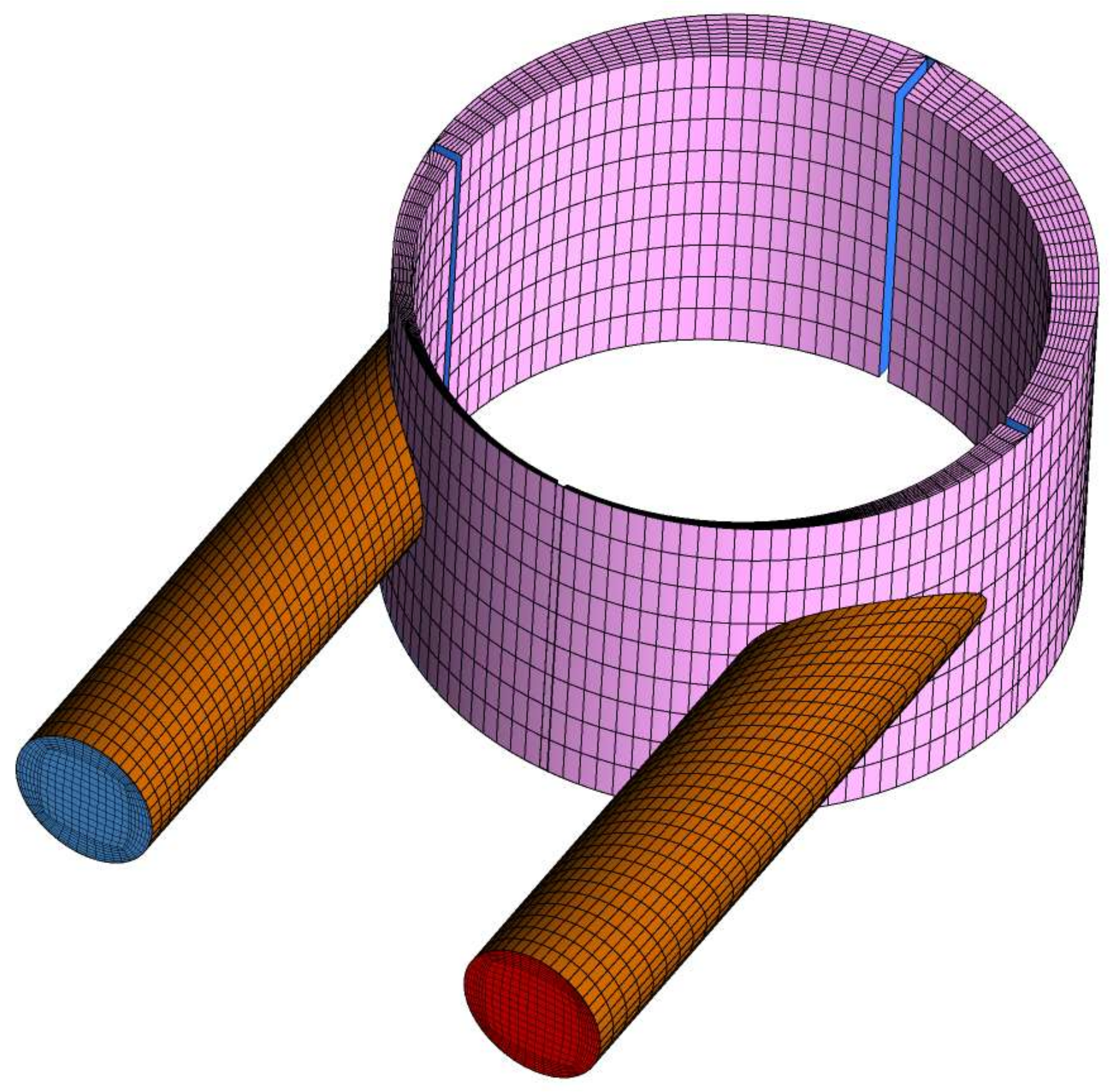
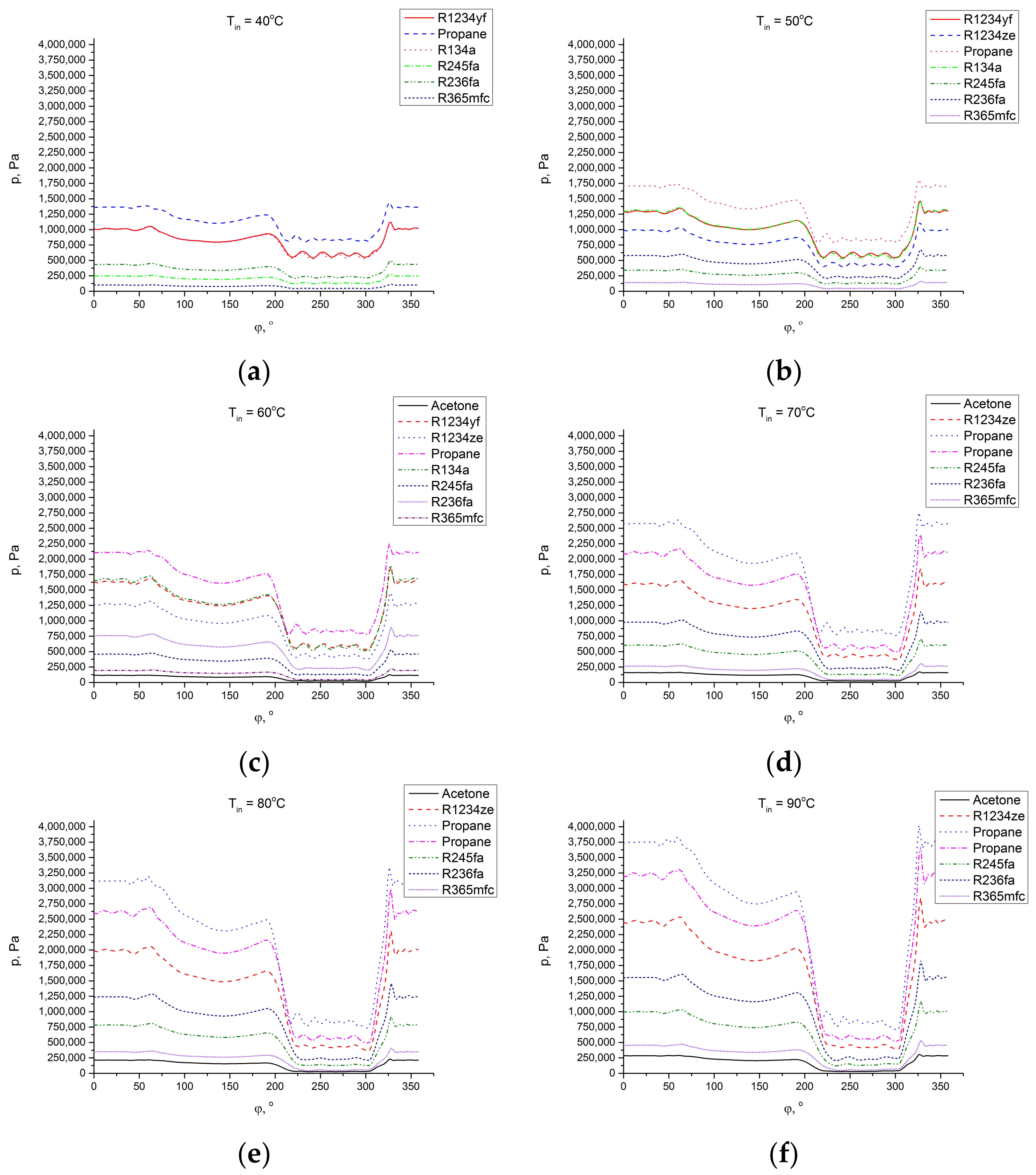


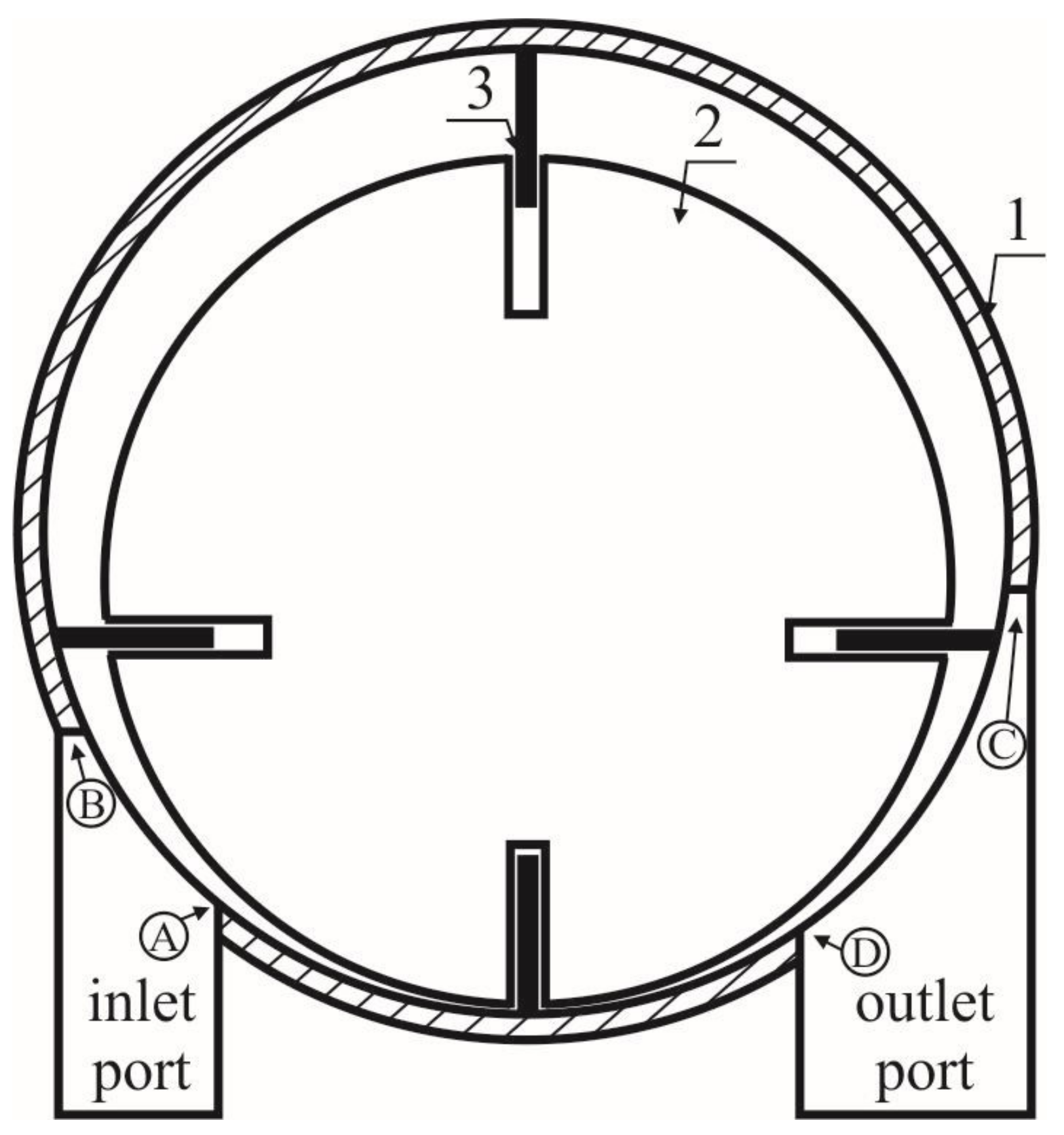

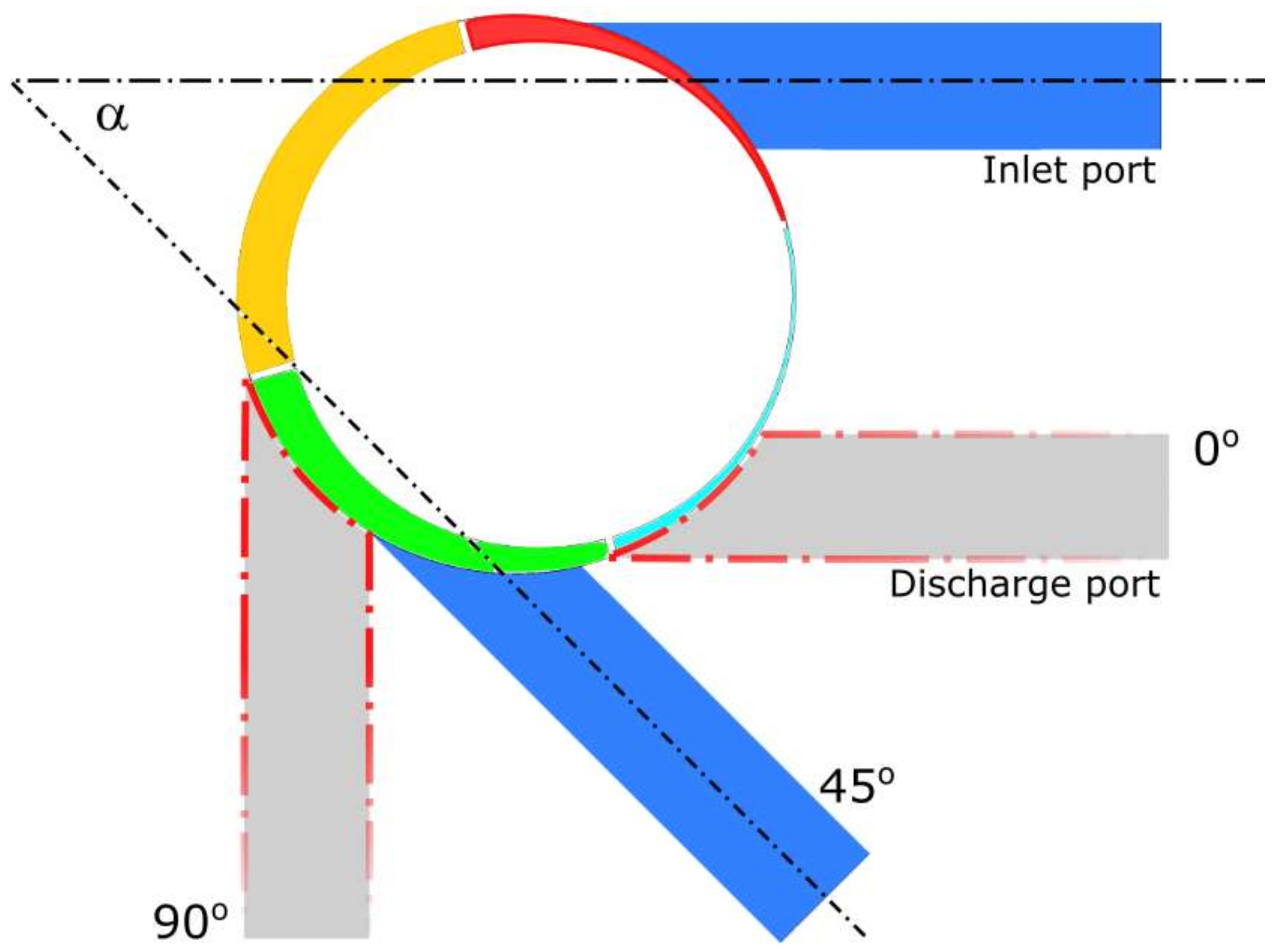
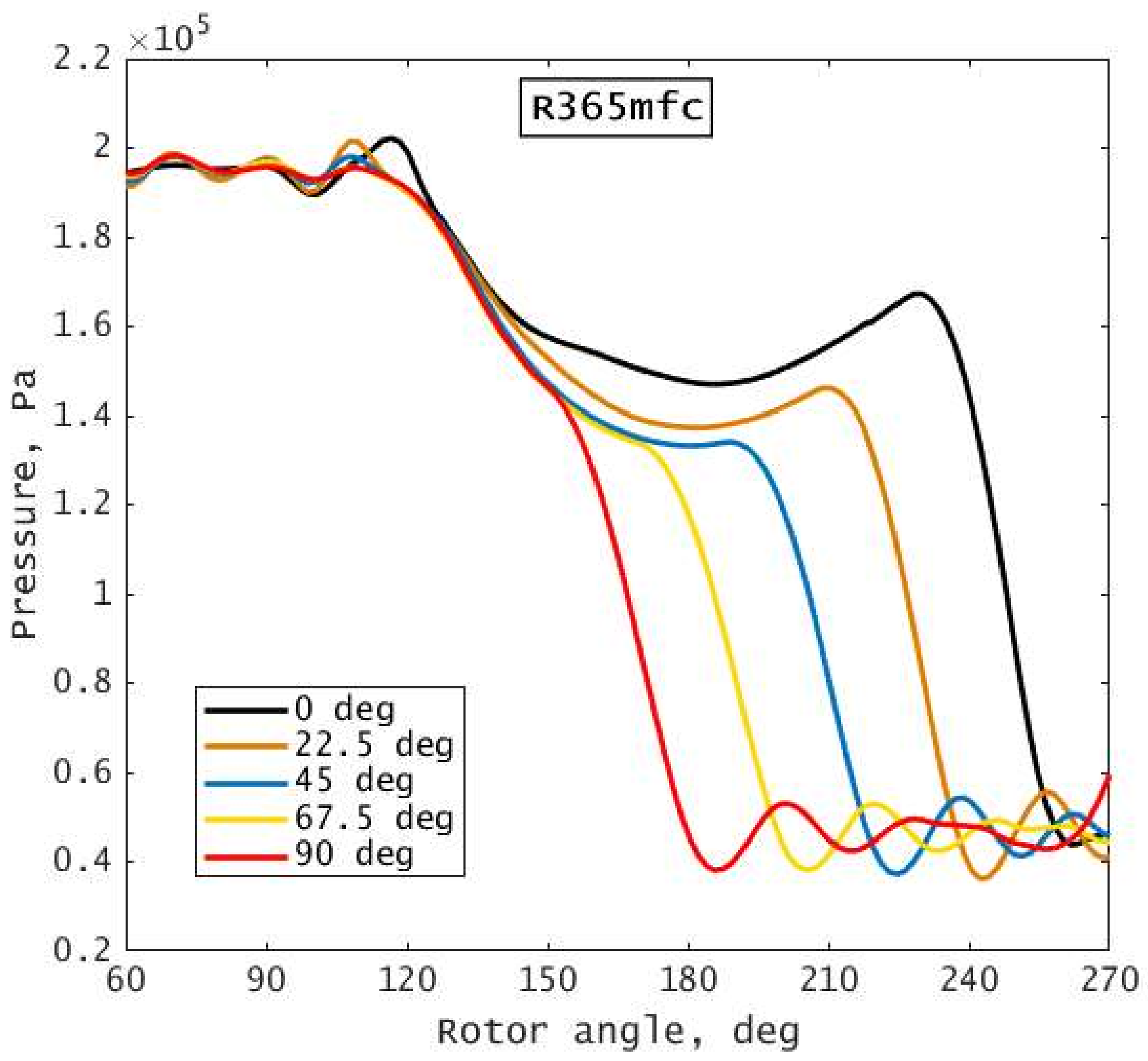

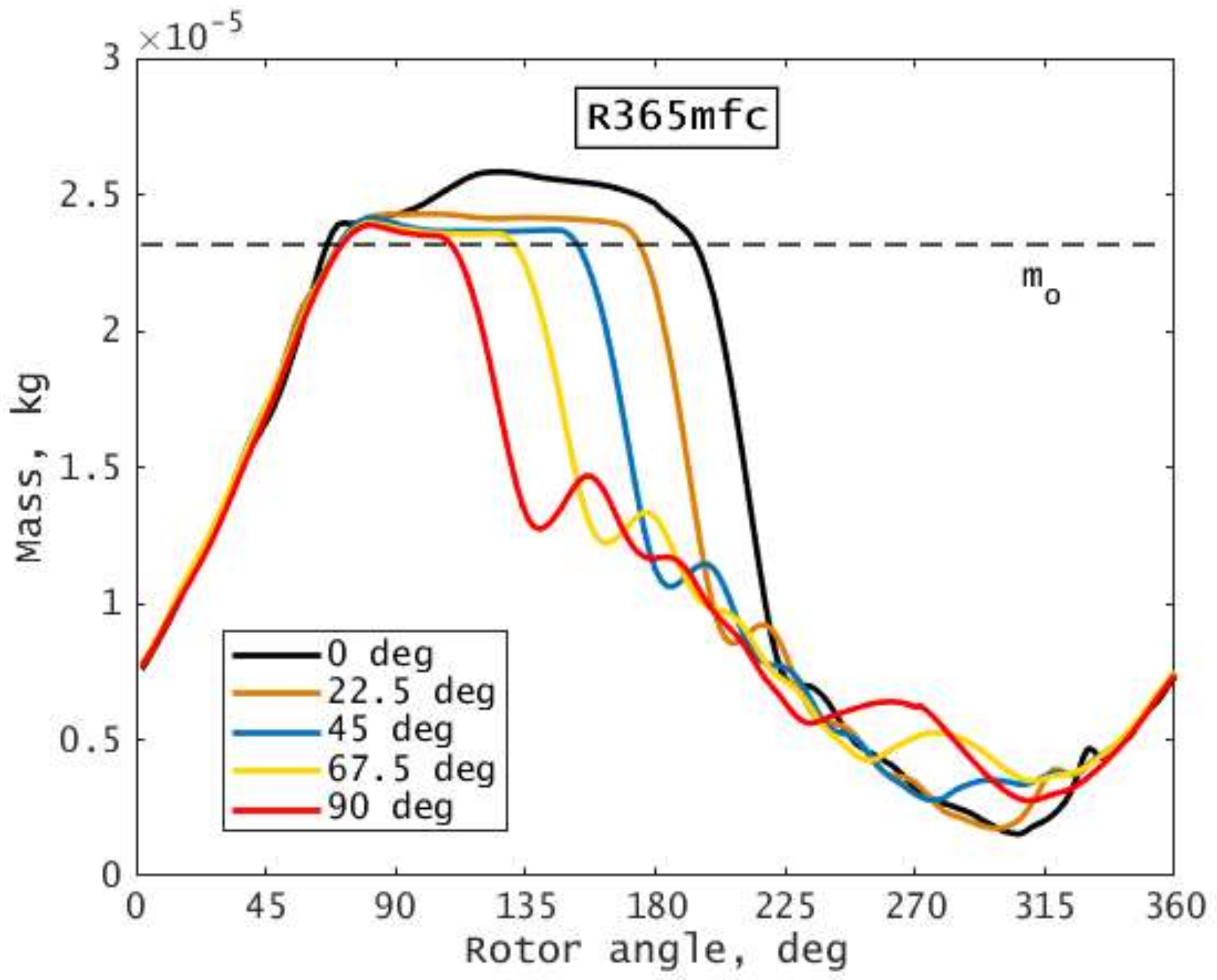
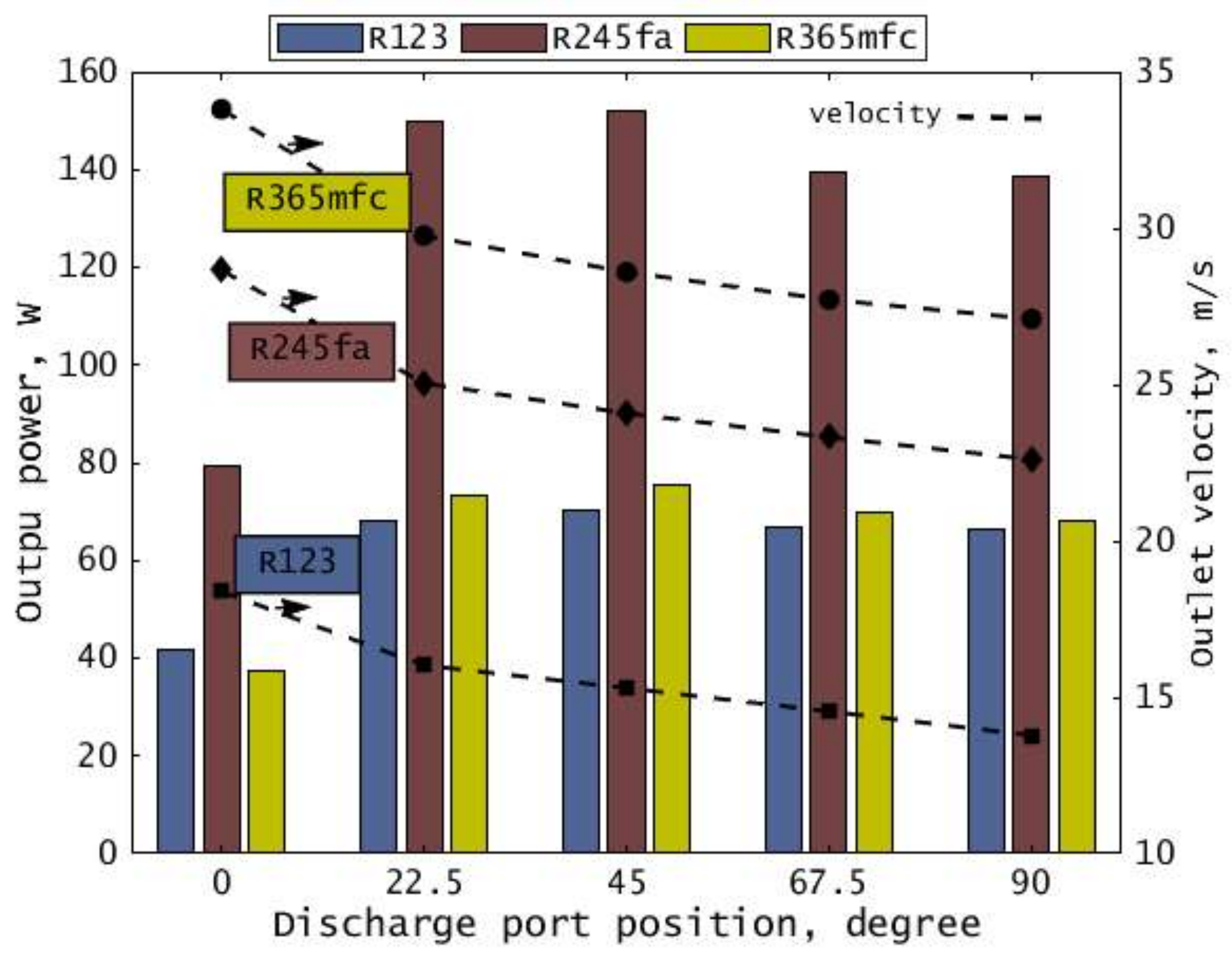
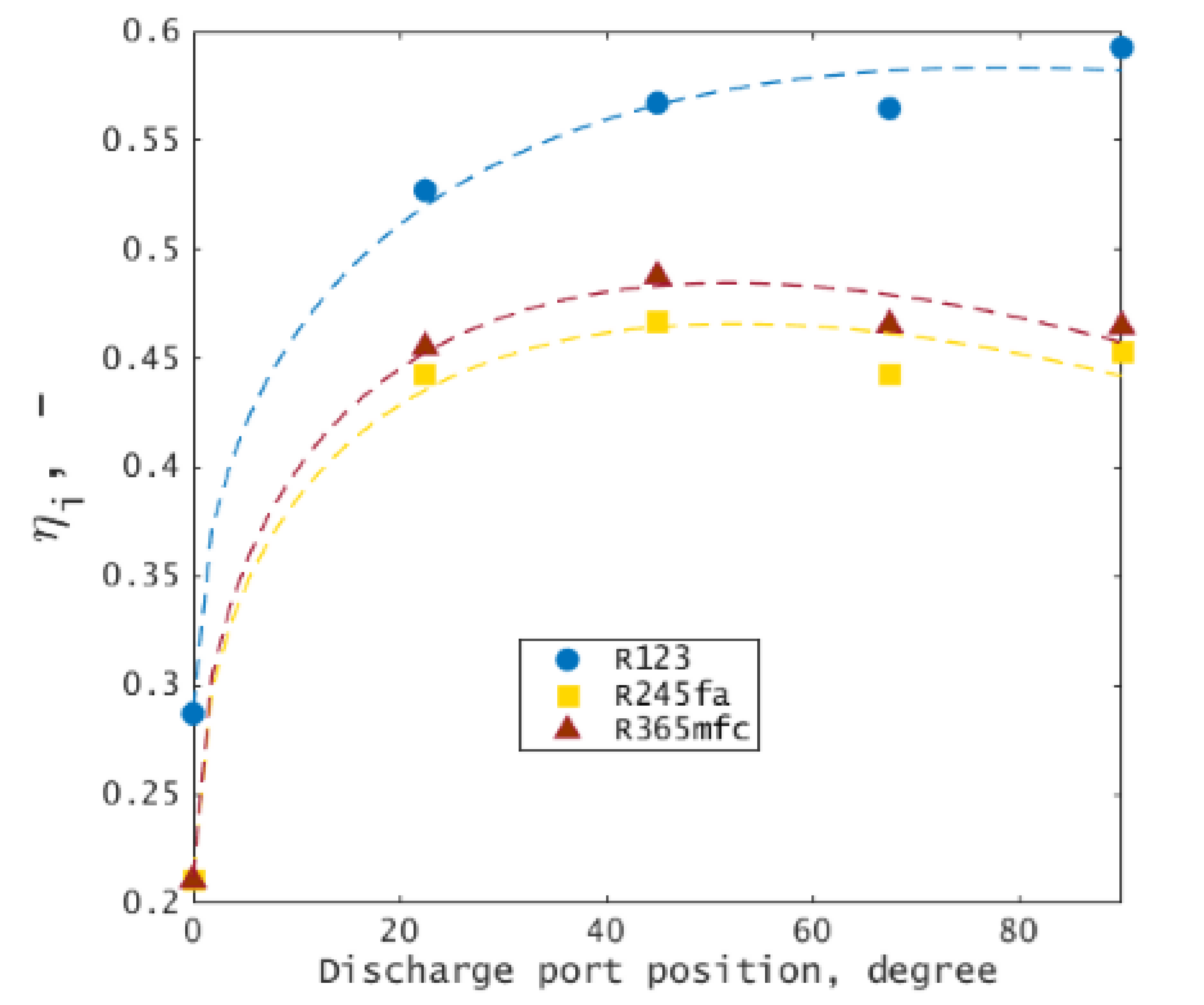
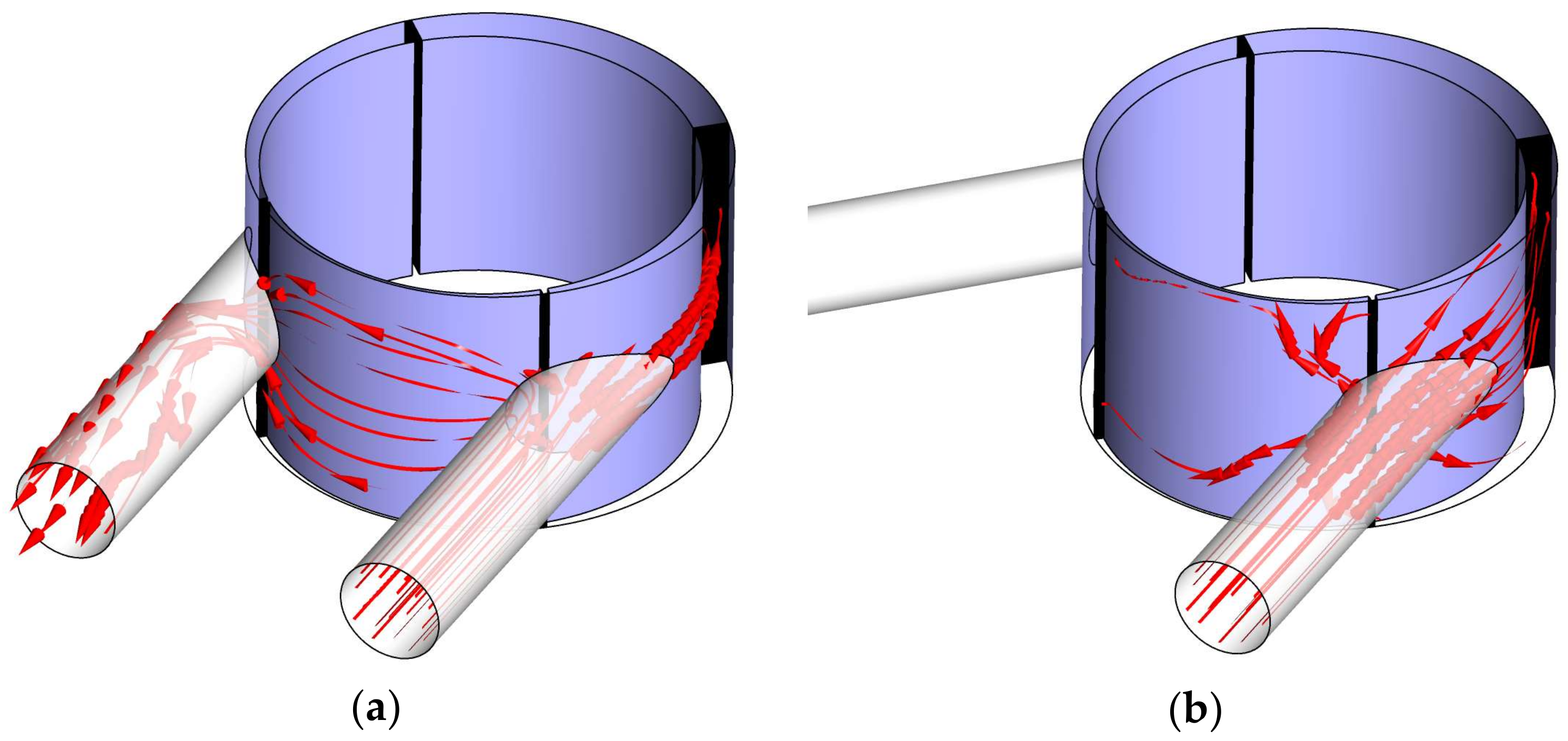
| Parameter | Value | Remarks |
|---|---|---|
| Inlet temperature | 40–90 °C | With steps of 10 degrees |
| Inlet pressure | Type of the working fluid and its saturation pressure at the inlet temperature | - |
| Condenser temperature | 20 °C | - |
| Condenser pressure | Saturation pressure at 20 °C | depending on the working fluid |
| Time step | 5.5 × 10−5 s | 1 degree of revolution |
| Total time | 0.1 s | 5 full revolutions |
| Turbulence model | k-epsilon | Standard model |
| Wall heat transfer | Adiabatic | - |
| Vane-to-wall clearance | 40 μm | constant |
| Working Medium | tin | pin | σ | n |
|---|---|---|---|---|
| °C | bar | - | rpm | |
| R123 | 60 °C | 2.86 | 3.6 | 3000 |
| R245fa | 4.63 | 4.3 | ||
| R365mfc | 1.97 | 2.0 |
© 2018 by the authors. Licensee MDPI, Basel, Switzerland. This article is an open access article distributed under the terms and conditions of the Creative Commons Attribution (CC BY) license (http://creativecommons.org/licenses/by/4.0/).
Share and Cite
Rak, J.; Błasiak, P.; Kolasiński, P. Influence of the Applied Working Fluid and the Arrangement of the Steering Edges on Multi-Vane Expander Performance in Micro ORC System. Energies 2018, 11, 892. https://doi.org/10.3390/en11040892
Rak J, Błasiak P, Kolasiński P. Influence of the Applied Working Fluid and the Arrangement of the Steering Edges on Multi-Vane Expander Performance in Micro ORC System. Energies. 2018; 11(4):892. https://doi.org/10.3390/en11040892
Chicago/Turabian StyleRak, Józef, Przemysław Błasiak, and Piotr Kolasiński. 2018. "Influence of the Applied Working Fluid and the Arrangement of the Steering Edges on Multi-Vane Expander Performance in Micro ORC System" Energies 11, no. 4: 892. https://doi.org/10.3390/en11040892





